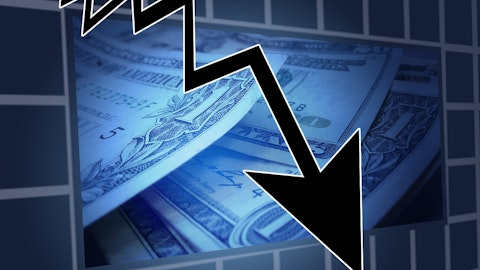Durgesh Chopra: Okay. So but just to be clear though, Steve, I mean, next year, you feel with the plan that you have in place that versus your downgrade thresholds, you’ll exceed them, right, into 2024?
Steve Coughlin: Yes, absolutely. This is a top priority metric in all of our planning. So maintaining investment credit is at the top. And so as we look at the asset sales — keep in mind, we already had a significant amount, $2.7 billion to $3 billion considered in our Investor Day numbers. And we are prioritizing assets that both hit our strategy, but as well are minimally dilutive on earnings, cash and credit. So I’m very confident that we will not impact our credit metrics negatively with the plans that we have.
Durgesh Chopra: Got it. Perfect. And I know just — but I just want to ask just one last question, and then I’ll pass it on to others. But just Andres you mentioned active discussions with a lot of parties on assets. $3.5 billion is already very significant in asset sales. Could that number be higher as you sort of get more interest as you have those discussions?
Andres Gluski: At this point in time, I would say that we feel that we will sell at least $3.5 billion through end of 2027, but a lot of these, again, are partial sell-down, sell-down of renewables, our plan to exit from coal. So if you look in the past, we’ve done a multiple of this number. I’d also point out that I’m not aware of any time that we have set a target for asset sales and not achieved it or exceeded it. So we feel very confident in achieving those asset sale numbers.
Operator: The next question will be from the line of Angie Storozynski with Seaport Global. Your line is now open.
Angie Storozynski: Okay. So first, I wanted to — you mentioned about — you mentioned transferability of tax credits. I just wanted to make sure that were not in a sense window dressing and trying to solve for a certain credit metrics, but this is actually driven by economics. So when I look back to your Analyst Day, you financed your renewables in the U.S., 40% tax equity, 40% project level debt and then 20% equity. So I just wanted to make sure that, that structure is still in and we’re not trying to basically boost credit metrics by levering these projects more? And again, just explain to me that why we’re moving from the traditional credit — tax equity structures, which allowed you to monetize accelerated depreciation, among others to the transferability?
Steve Coughlin: Yes. Angie, it’s Steve. Thanks for the question. No, it is important to recognize that AES has always been maximizing their tax credit value. And so that continues to be the case. The reality is the transfers offer a more — a broader market — a broader set of market participants. I think a more liquid market, so many more corporates coming in from different sectors. It’s a faster, simpler transaction to execute, but we’ll still do both because it’s important that you not only monetize the tax credit value but also the benefit of the accelerated depreciation which is not something that’s transferable and does require either AES or a partner in the asset to be able to utilize that accelerated depreciation benefit.
So there’ll be hybrids done here. But my primary point is that it is a broader market, simpler transactions, more liquidity. And I do think it’s appropriate that it shows up in operating cash and free cash because this is truly an important component of value and a return to the investment that gets made in the assets.
Angie Storozynski: Okay. So that’s treatment so that the FFO uplift under those structures, you already considered that when you quantified your equity needs during the Analyst Day?
Steve Coughlin: So I would say at this point, we have already done 500 megawatts in transfer credits. The market is moving faster. So, I think in the Analyst Day, I would say there’s upside in terms of our cash flow metrics related to the use of more transferability. But it’s not necessarily something that is changing returns or anything. It’s just that it’s creating more visibility, more market participation and shows up in the operating cash flow.
Angie Storozynski: Okay. But again, it’s — you’re still sticking with solar ITCs. Again, that financing structure that I mentioned at the beginning, doesn’t change, right? So you’re not increasing leverage of the project, okay.
Steve Coughlin: No, we are not just to be clear. So we are not increasing leverage at the projects that we are only looking to monetize the tax credits as efficiently as possible. And I would expect that given our credibility and our track record, any discount applied to the credits will be quite small relative to perhaps other market participants. And then, Andy, just also to reiterate, as I have said in the past, we choose the credit option based on what is the best cash financial return from the credit. So whether in most cases, that’s been ITC for us, it makes very little sense to be choosing production-based credits, for example, in New England solar, where the capacity factors tend to be quite small. So I would question anyone that’s doing that in their motives, but we are very focused on what’s the credit that is yield the best return.
Angie Storozynski: Okay. And then secondly, you mentioned the attractiveness of renewables versus other sources of power based on the levelized cost of electricity, so i.e., new-builds for renewables versus new-builds for thermal assets. But — and not everywhere, do you have to actually add incremental generation sources, right? And then the pushback that we are hearing is that the PPA prices have now slightly exceeded forward power prices, be it on peak for solar or around the clock for wind. So again, I understand the distinction with tech clients, but how about any other locations and any other off-takers for new renewables?
Andres Gluski: Well, again, we’re talking about the markets where we’re located. And the way I look at it is a little bit different. I mean, in terms of the energy, the LCOE, again, as I said, in most markets that we’re operating, it is the cheapest. The issue with renewables is really having that dispatchable 24/7. So you need to complement it with regular power or batteries, which will require even more renewals. But I think the state is a huge play. So you can’t say in every single location. But certainly in states that have high solar radiation or high wind, that’s just the fact. I mean, the real issue is more having the 24/7 capability.





